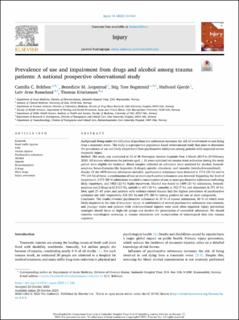| dc.contributor.author | Bråthen, Camilla Christin | |
| dc.contributor.author | Jørgenrud, Benedicte Marie | |
| dc.contributor.author | Bogstrand, Stig Tore | |
| dc.contributor.author | Gjerde, Hallvard | |
| dc.contributor.author | Rosseland, Leiv Arne | |
| dc.contributor.author | Kristiansen, Thomas | |
| dc.date.accessioned | 2024-01-18T08:09:10Z | |
| dc.date.available | 2024-01-18T08:09:10Z | |
| dc.date.created | 2023-11-27T17:07:28Z | |
| dc.date.issued | 2023 | |
| dc.identifier.citation | Injury. 2023, 54 (12), . | en_US |
| dc.identifier.issn | 0020-1383 | |
| dc.identifier.uri | https://hdl.handle.net/11250/3112352 | |
| dc.description.abstract | Background: Being under the influence of psychoactive substances increases the risk of involvement in and dying from a traumatic event. The study is a prospective population-based observational study that aims to determine the prevalence of use and likely impairment from psychoactive substances among patients with suspected severe traumatic injury. Method: This study was conducted at 35 of 38 Norwegian trauma hospitals from 1 March 2019 to 29 February 2020. All trauma admissions for patients aged ≥ 16 years admitted via trauma team activation during the study period were eligible for inclusion. Blood samples collected on admission were analysed for alcohol, benzodiazepines, benzodiazepine-like hypnotics (Z-drugs), opioids, stimulants, and cannabis (tetrahydrocannabinol). Results: Of the 4878 trauma admissions included, psychoactive substances were detected in 1714 (35 %) and in 771 (45 %) of these, a combination of two or more psychoactive substances was detected. Regarding the level of impairment, 1373 (28 %) admissions revealed a concentration of one or more psychoactive substances indicating likely impairment, and 1052 (22 %) highly impairment. Alcohol was found in 1009 (21 %) admissions, benzodiazepines and Z-drugs in 613 (13 %), opioids in 467 (10 %), cannabis in 352 (7 %), and stimulants in 371 (8 %). Men aged 27-43 years and patients with violence-related trauma had the highest prevalence of psychoactive substance use with respectively 424 (50 %) and 275 (80 %) testing positive for one or more compounds. Conclusion: The results revealed psychoactive substances in 35 % of trauma admissions, 80 % of which were likely impaired at the time of traumatic injury. A combination of several psychoactive substances was common, and younger males and patients with violence-related injuries were most often impaired. Injury prevention strategies should focus on high-risk groups and involve the prescription of controlled substances. We should consider toxicological screening in trauma admissions and incorporation of toxicological data into trauma registries. | en_US |
| dc.language.iso | eng | en_US |
| dc.relation.uri | https://www.clinicalkey.com/service/content/pdf/watermarked/1-s2.0-S002013832300877X.pdf?locale=en_US&searchIndex= | |
| dc.rights | Navngivelse-Ikkekommersiell 4.0 Internasjonal | * |
| dc.rights.uri | http://creativecommons.org/licenses/by-nc/4.0/deed.no | * |
| dc.title | Prevalence of use and impairment from drugs and alcohol among trauma patients: A national prospective observational study | en_US |
| dc.type | Peer reviewed | en_US |
| dc.type | Journal article | en_US |
| dc.description.version | publishedVersion | en_US |
| cristin.ispublished | true | |
| cristin.fulltext | original | |
| cristin.qualitycode | 1 | |
| dc.identifier.doi | 10.1016/j.injury.2023.111160 | |
| dc.identifier.cristin | 2203272 | |
| dc.source.journal | Injury | en_US |
| dc.source.volume | 54 | en_US |
| dc.source.issue | 12 | en_US |
| dc.source.pagenumber | 9 | en_US |

